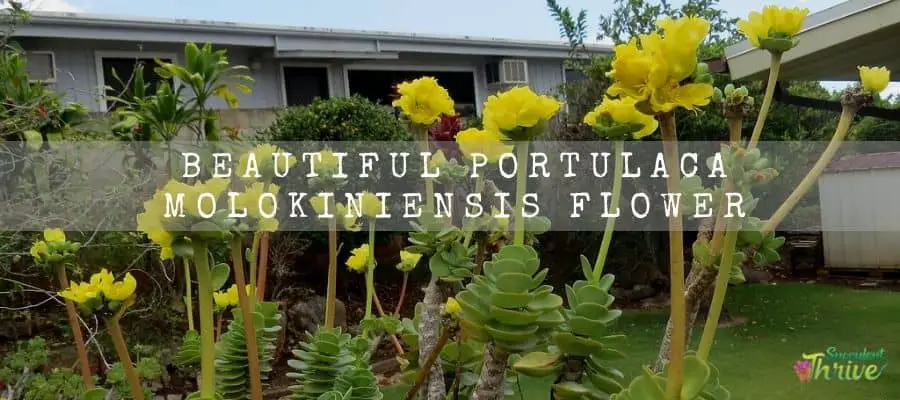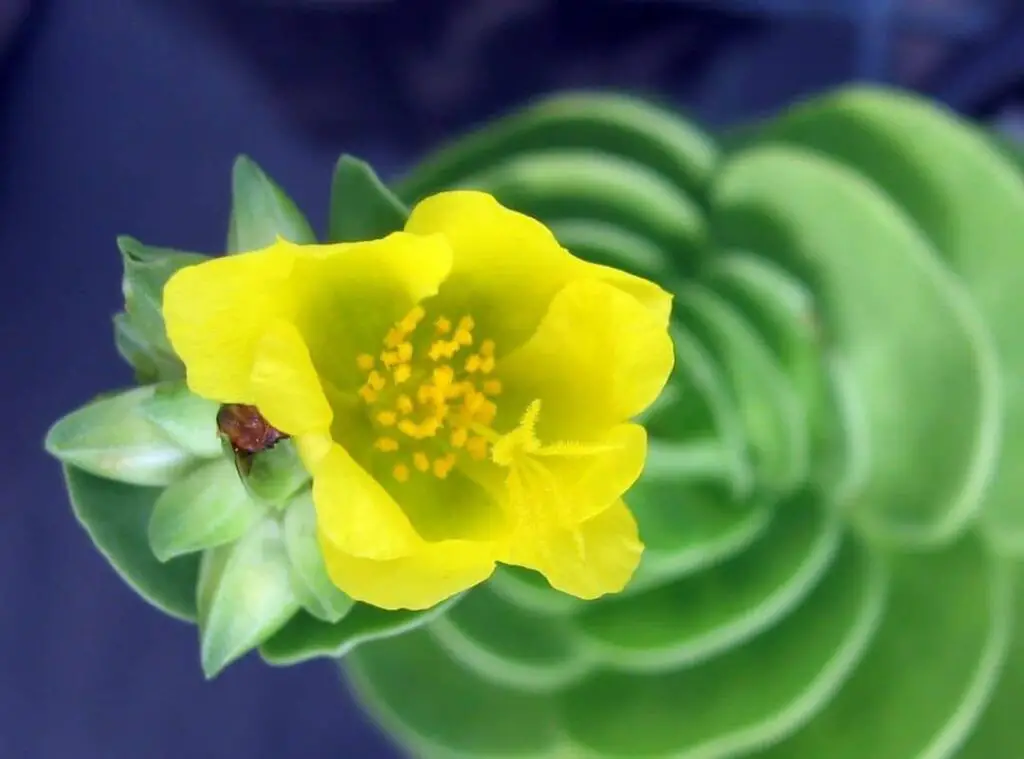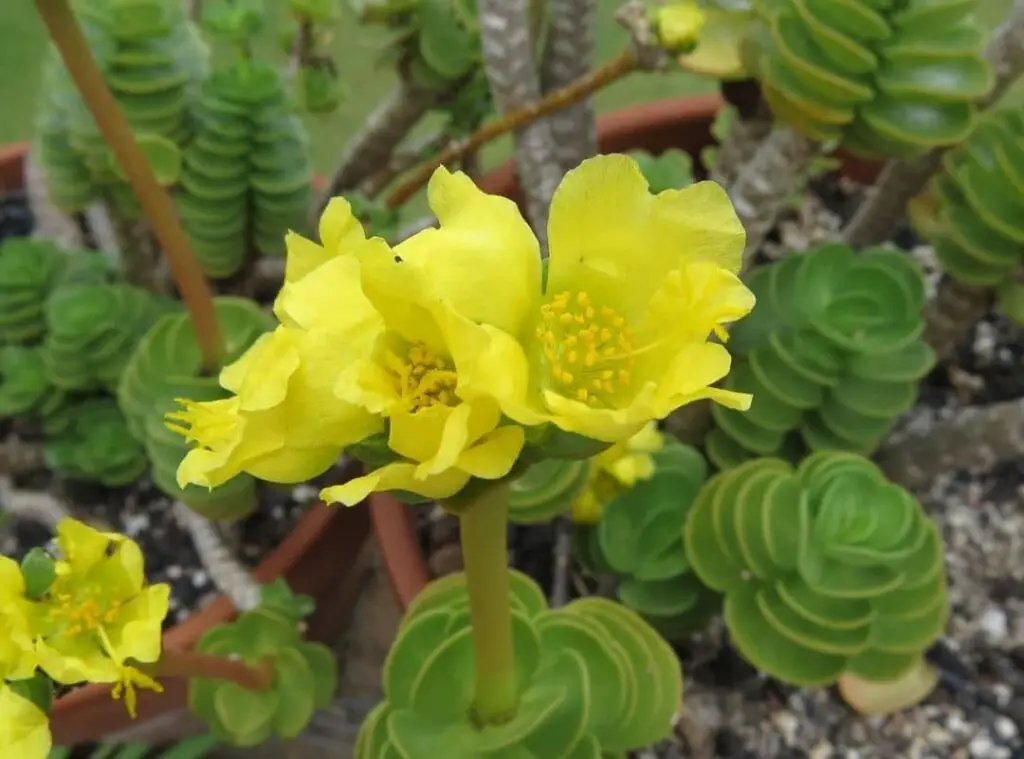Of course, Portulaca molokiniensis flowers do not look ordinary. They are small but have their own unique characteristics. If you have a Portulaca molokiniensis plant and do not know how to get flowers from it, this article is for you.
The flowers of Portulaca molokiniensis are lovely and can take on yellow hues. You could spot these cup-shaped flowers developing on the tips of the stems. They are tiny in size, yet they add so much grace to the entire outlook of the plants.
These plants usually grow at a rapid pace. They would be great picks for indoor gardening. Besides, they can perform well in outdoor conditions too. So, from this article I will be mainly explaining the flowers they produce, how you should take care of them etc.

What is this plant?
To briefly explain on the Portulaca molokiniensis plants, they somewhat look contrast with the other succulents. They come up with multiple branches usually. Further Portulaca molokiniensis stems would tend to grow in clumps which would eventually form a dense shrub. Portulaca molokiniensis plant stems would be 1 inch in diameter. Further they would grow upwards.
In terms of the heights of the plants, they would rise to a maximum height of 12 inches. Each stem would consist of about 4 rows of leaves. The leaves would be more elongated. Besides, their leaves tips would be round. The length of the leaves would be 2 inches. You could spot their leaves in a wide array of colors. In fact, it could vary from pale green to much darker green color.
How often do Portulaca molokiniensis flowers?
Portulaca molokiniensis plants produce flowers from late spring to late summer. Having said that, when you cultivate them indoors, they can have sporadic to continuous blooming periods.
Colors of Portulaca molokiniensis flowers
You could spot the Portulaca molokiniensis flowers forming in yellow to golden colors. Those flowers would form in clusters. They would arise from the center of the leaves and develop on the tips of the stems.

How long do Portulaca molokiniensis flowers last?
Portulaca molokiniensis flowers usually stay alive for one day. Having said that, if the flower stalks carry several flowers, they will stay in bloom for several days.
How to make Portulaca molokiniensis flowers?
Portulaca molokiniensis are soft succulents. Thus, it is important that you provide the right growing conditions for them to flower. Literally do not expose the plants for hard frost as they simply cannot withstand such conditions. Ideally you could bring them indoors to protect the plants from such unhealthy conditions.
However even if you bring them indoors, you need to ensure that you expose the plants to sufficient sunlight. If they lack sunlight, you could supplement light by placing grow lights closer to the plants. In addition to that, it is vital that you grow them in well-draining pots and water them moderately yet infrequently which would help them to thrive better. Last but not least, grow them in a well-draining soil mix too. These are the basic growing care tips which would help them to make flowers.
How to care for Portulaca molokiniensis flowers?
Portulaca molokiniensis plants are versatile and tough plants. In other words, they would not want major attention from you. All you need to assure is that you provide the main necessities for them to grow well.
Light requirement
Portulaca molokiniensis plants opt to have plenty of direct sunlight to keep their plants in full bloom. So, if you desire to grow them outdoors, you need to proceed with a bright sunny spot where the plants can ideally gain sunlight for about 6 hours. Having said that, they can also tolerate direct sunlight for some more time too. This is a quite evident fact as these are adapted to grow in hot and arid areas such as Hawaii.
They are quite adapted to grow in strong sunlight when they grow in these areas. So, in cultivation you need to mimic the same conditions. On the other hand, if you want to plant them as indoor plants, I encourage you to keep the plants somewhere closer to a bright sunny windowsill.
It would be the best place where they can thrive well since they can fulfill their sunlight requirement. However, if you think the plants are still lacking adequate sunlight, you need to provide grow lights closer to the plants. You could easily find these from the garden stores and from the nurseries as well.
It is important they have chlorophyll so that they can conduct the photosynthesis process. So, to produce chlorophyll the plants need to have sufficient sunlight. Hence, you could consider placing electric lights to supplement the light. They would encourage the photosynthesis process

Water requirement
Portulaca molokiniensis plants are drought tolerant plants. Simply they would perform well in hot and arid areas where they can perform well with minimal water. So, you need to keep that always in mind when watering the Portulaca molokiniensis in cultivation.
Portulaca molokiniensis leaves are wide and their surface would be absorbent. That feature helps them to conserve water for extended periods. So, best is to water the plants once every week or once every ten days. Furthermore, when you water the plants, you should avoid soaking the plants. Instead, water them to make their soil moistened.
That would help them to survive. In addition to proper watering, it is important that you grow the plants in a well-draining pot as well. It would ensure that no extra water is retained in the pot. If you expose the plants roots for soggy waterlogged conditions, it would make the plants prone towards bacterial infections and for fungal infections.
Temperature requirement
Portulaca molokiniensis are the type of plants which would perform well in warmer weather conditions. They love both sunlight and heat. That said they would not tolerate frost though. . Thus, the exposure for extreme frost conditions could only bring adverse impact on the flowers as well as on the plants.
Having said that, if you live in a mild climate, undoubtedly you could grow them as outdoor plants. That said, if you constantly go through frost conditions , you need to pot them and bring them indoors when the weather conditions get much colder. Keep in mind that you don’t expose the plants to temperatures below 25 degrees Fahrenheit.
If you accidently expose the plants to frost, it will badly impact the cell organization of the plants. Literally it would make the cell swollen and make them frozen. Chances are that it would even kill the plants. So, if you had kept the plants grown outdoors, you should protect the plants by covering them with frost clothes.
Soil requirement
A soil medium which has a fast-draining quality would suit Portulaca molokiniensis the best. Once you grow them in a well-draining soil mix, it would ensure that you are not making the plants more prone towards root rot etc. in addition to the excellent drainage , it is critical that it has a good aeration as well.
It would further help to better the drainage of the soil mix. So, a soil mix of cactus potting soil and mineral grit which is mixed at 1:1 would work well with them. To further explain on mineral grit, it could be a mix of coarse sand, pumice, perlite. Further you may use them individually too.
Conclusion
Before wrapping this up, Portulaca molokiniensis are such spectacular plants. It would be a treat to watch them when they are in full bloom. So, I hope you found the above information very useful and that now you are confident in handling them.
Read Next : Austrocylindropuntia Subulata Dying (9 Important Facts)
